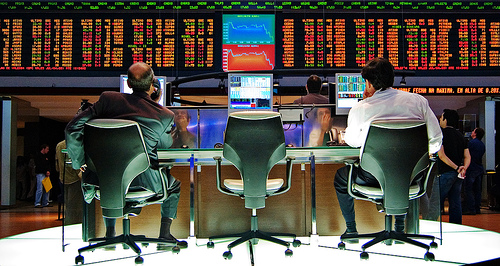What is swing trading? What is a swing trader? What are swing trade stocks?
Most people are familiar with the basic concepts of investing, like day trading, penny stocks, or other popular methods of buying and selling securities. But even though they’re quite common, swing trade stocks aren’t something you hear about often. Swing trading, however, is an incredibly lucrative trading method that has the potential for considerable rewards.
Put simply, swing trading is a short-term trading method for stocks and options. Typically lasting two to six days, swing trading positions aim to identify a trend and find gains within it, which can lead to significant annual profits.
Settling into the middle of a continuum between day trading and trend trading, swing trading isn’t as extreme as these other methods. It does involve specific risks that differ from other investment strategies, however, which are important to understand if you want to take advantage of swing trading opportunities.
What Is Swing Trading?
So, what is swing trading exactly? Swing trading uses technical analysis to find stocks with short-term price momentum and uses the fundamental value of stocks combined with price trends and patterns to get returns.
Swing trading is typically done by day traders, because maximizing the value of this strategy requires quick decisions to find situations in which a stock has potential for big moves within a short time frame. Large brokerage firms deal almost exclusively in big trade sizes that can’t be bought and sold quickly, giving an individual trader an opportunity to take advantage of short-term movements without needing to compete with these large firms.
Swing traders aim to hold a position only long enough to capture a larger price move. This requires careful position sizing, which refers to the number of units invested in a particular security by an investor or trader, determined by the investor’s account size and risk tolerance.
This maximizes returns and limits downside risk, which is an estimation of a security’s potential to experience a significant decline in value due to market changes, as well as an estimate of how much of that loss could be sustained.
Swing Trading Analysis
A combination of both fundamental analysis and technical analysis is used to determine swing trading positions. These two main analyses are used for all investment strategy, though individual investors may prefer one type over another. Technical analysis uses the price movement of a security to predict its future movements, while fundamental analysis uses the economic and financial factors that influence a business and its securities.
Time frame charts factor into the analysis as well, and swing traders need to have the ability to identify an underlying trend and adjust the trade accordingly. Because swing trading settles into the middle ground between day trading and trend trader, it uses 15-minute, 60-minute, daily, and weekly charts to inform the decision-making process.
Day Trading vs. Swing Trading
Explained as simply as possible, the distinction between day trading and swing trading comes down to the hold time. At a minimum, swing trading involves an overnight hold, whereas day trading aims to close out positions before the market closes for the day. Because of this, day trading is focused purely on trends within the day and requires fast decision-making that doesn’t account for changes that can occur beyond market close. Day traders also need to consider that a stock could open much stronger than it closed the day before and adjust their strategy.
Swing trading, on the other hand, involves a hold for several days to weeks, which carries the risk of the unpredictability of the overnight, such as gaps from news announcements after hours that can cause a stock to go up or down. Swing trades usually use a smaller position size as well, because day trading takes a large position size to leverage through the margin.
Day trading is subject to pattern day trader regulations as well. If a day trader makes four or more round-trip day trades during any period of five consecutive business days, and those trades make up more than 6 percent of the total number of trades during that period, they’ll be designated a pattern day trader and be required to meet certain requirements and restrictions. Stock options and short sells count toward the trade limit as well, provided they occur during the same five-day period.
Swing trading can use an overnight margin of 50 percent if the account meets the pattern day trading requirement of having at least $25,000 in account equity. Swing trading on a margin can be especially risky in the event of a margin call, which is a situation in which a broker demands the investor deposit extra money or securities to meet the demands of the maintenance margin. This occurs when one or more of the securities held in the margin account drop below a certain value.
Day traders need to stay intently focused on their positions as well, looking for new potential opportunities and replacing exited positions. This creates a considerable time commitment and a lot of pressure, which can lead to stronger emotions and stress, both of which compromise the decision-making process.
Swing trading has ebbs and flows of transactions, and the hold period allows traders to use alert systems or occasional monitoring to maintain favorable positions. This allows for diversified investments and balanced, rational decision making.
How to Swing Trade: Swing Trading Strategy
With a typical stock position, the target is 20 to 25 percent profit for the majority of the stocks. Swing trading uses a smaller profit goal, usually around 10 percent, or in the case of tougher markets, 5 percent. While this may seem like a miniscule goal, the time period of swing trading is what has the potential to turn these into incredible gains.
Unlike day traders looking for immediate returns, or a long-term investor looking for gains over months or years, the average length of a swing trade is five to 10 days. The returns may be small in this case, but they all compound to create incredible returns that are equal to, or sometimes greater, than long-term returns.
Risks and losses are still there, however, so they need to be factored into the overall strategy. The goal with swing trading is the keep the losses small and the returns modest, so your wins always outweigh your losses. Instead of a typical 7 to 8 percent stop loss, for example, take losses at a maximum of 2 to 3 percent to maintain a 3-to-1 profit-to-loss ratio, which leads to success. Keeping this strategy in place is vital to your profits, since one unbalanced loss can destroy all your smaller gains.
Choosing the Right Stocks for Swing Trading
Like any other type of trade, swing trading is about choosing the right stocks. Large-cap stocks are the best candidates for these short-term holds, which are the most actively traded stocks. Also called “big cap” stocks, large-cap stocks — short for “large market capitalization” — refer to companies with a market capitalization value of over $10 billion. Market capitalization is determined by multiplying the number of a company’s shares outstanding by its stock price per share.
Large-cap stocks account for 91 percent of the total U.S. equities market and include such giants as Apple, Alphabet and Microsoft. Global large-cap companies can be found on the benchmark indexes, such as the Dow Jones Industrial Average, NASDAQ Composite and the S&P 500.
Large-cap stocks are often viewed as core portfolio investments for several reasons, including:
- Transparency. Large-cap companies are transparent, making it much easier for investors to analyze public information about those companies.
- High dividends. Large-cap, stable, established companies are usually chosen for dividend income distributions, due to their mature market establishment and ability to contribute to high dividend ratios.
- Stability. Large-cap stocks are often blue-chip companies in the peak of their business cycle phases, giving them established and stable revenue. They lead the market and move within the market economy due to their size and provide innovative solutions that impact the broad market as a whole.
In an active market, large-cap stocks will swing between broadly defined high and low extremes, giving the swing trader a unique opportunity to ride this wave in one direction for a short period, switching to the opposite side when the stock changes direction.
Choosing the Right Market

Image via Flickr by rednuht
Market conditions are described as “bull” or “bear,” and should be a major force in determining your stock positions. These terms refer to the stock market conditions overall and whether positions are appreciating or depreciating in value. The market is also influenced by the attitude of the investors, however, so these terms can also describe the investors’ current attitudes toward the market and its trends.
A “bull” market refers to a market that’s on the rise, as noted by a sustained increase in the market share prices. This gives investors hope that the uptrend will continue over time, signifying that the economy is strong and employment levels are high.
In contrast, the “bear” market is on a decline. The share prices are steadily dropping, leading to a downward trend that investors believe will continue, which results in a downward spiral. The economy slows down and unemployment rises in a bear market, due to companies laying off portions of their workforce.
Some characteristics of these markets include:
- Supply and demand. In a bull market, the demand is strong and the supply of securities is weak, so many investors want to buy while few are selling. This causes share prices to rise as investors compete. In a bear market, more people are looking to sell than buy, and the share prices drop.
- Psychology. The investors’ perceptions of the market behavior both impact and reflect the market, so that can influence whether the market will rise or fall. The performance of the market and the psychology and confidence of the investors is a mutually dependent relationship. In a bull market, investors are eager to participate and earn a profit. In a bear market, the tone is negative and investors are moving their money into fixed-income securities to ride out the storm and wait for positive moves.
- Economic activity. The businesses with stocks on the market exchange are part of the larger economy, making them intrinsically linked to one another. A bear market signifies a weak economy in which most businesses aren’t reporting huge profits because consumers aren’t spending enough, which affects the market value of stocks. A bull market signifies a strong economy in which businesses are experiencing profits and consumers are willing and able to spend, which drives the market value of stocks up.
For the swing trader, the challenges with each of these extremes is different than working with a stagnated market. In either a bearish or bullish market, the most active stocks are unlikely to experience the marked oscillations that they would when the indexes are stable for longer periods. The momentum of bear and bull markets carries stocks in one direction only, over a longer period of time, leading the swing trader to trade on the basis of the longer-term directional trend, rather than riding the wave until it reverses direction.
Because of this, the swing trader is in the best position when the market is stagnant. In this situation, the indexes may rise for a few days, decline for a few days, and stick to this identifiable pattern over time, giving them an overall trend that remains close to the same. The savvy swing trader can catch these short-term movements to generate profits.
Like long-term trend trading, swing trading relies on the trader’s ability to identify the current market conditions accurately and react to them appropriately.
Using Moving Averages and Crossover Patterns
Analysis of the moving averages and crossover patterns provide support and resistance levels that can signal a swing trader to buy a stock. If a market moves up and pulls back, the highest point reached before the pullback is the resistance. As it moves back up, the lowest point reached before it climbs back is the support. Trading opportunities are here for the swing trader, such as taking a longer position near the support and a taking a shorter position near the resistance.
A simple moving average is an arithmetic moving average calculated by adding the recent closing prices then dividing them by the number of time periods in the calculation average. Short-term averages are exceptionally responsive to the changes in the underlying prices, while long-term averages are slow to react. Traders watch for short-term averages to cross above long-term averages to signify an uptrend. This provides levels of support and resistance, as well as identifying bullish and bearish patterns that signal price points to enter and exit stocks.
An exponential moving average is a moving average that places greater significance on the recent data points. Exponential moving averages react more significantly to recent price changes than simple moving averages. These averages are commonly used alongside other indicators to confirm market moves and gauge their validity, especially in fast-moving markets, as well as to identify clear trend signals and entry and exit points.
An exponential moving average crossover system can be used by interpreting the 9-period, 13-period and 50-period exponential moving averages to identify bullish and bearish crossovers.
- A bullish crossover occurs when the price crosses above the moving average after being below it, which may indicate that a reversal of pattern and an uptrend may be starting. If the 9-period exponential moving average crosses above the 13-period exponential moving average, it indicates a long entry point, but a 13-period exponential moving average has to be above the 50-period exponential moving average, or cross above it.
- A bearish crossover occurs when the price of a security falls below the exponential moving averages, which may indicate a potential reverse of a trend and can be used to time the exit of a long position. If the nine-period exponential moving average crosses below the 13-period exponential moving average, it indicates a short entry point or the exit of a long position, but the 13-period exponential moving average has to be below the 50-period exponential moving average, or cross below it.
When interpreted correctly, these calculations can determine trading bias and are very useful in the technical analysis application to confirm a market move or to indicate its strength. If used improperly or misinterpreted, however, these calculations can be detrimental to a trading strategy.
Using the Baseline Value
Historical data is useful for swing trading. Liquid stocks tend to trade above and below a baseline value, which is found on a chart with the exponential moving average. Once a swing trader applies the exponential moving average to identify the baseline, it can inform the decision to go long at the baseline while the stock is on its way up and short at the baseline while the is on its way down.
For a swing trader looking to maximize profits on a single trade, the ideal time to buy a stock right at the bottom or sell right at the top isn’t a concern. This trader will look for a stock to hit the baseline and confirm the direction to make a move.
Earning Profits
To collect a profit, the swing trader should exit the trade as close as possible to the price channel, which is the range between the support and resistance levels that a stock price has oscillated in within a given time period. This is a chart pattern that connects the stock’s price peaks and valleys over a period of time.
If a stock is fluctuating between highs and lows that show a distinctive pattern, a trader can use the channel to predict the future fluctuations and find gains. An example of this would be buying a stock when the price touches the lower channel line and setting a profit target at the upper channel line.
If a price has a breakout from the pattern, however, the channel loses its relevance as a predictive indicator. An upward breakout is bullish and a downward breakout is bearish, but it’s not uncommon for a stock to experience short price spikes above and below the channel line. Because of this, other indicators should always be used to confirm a breakout before making a decision.
Bullish vs. Bearish Swing Trading
For a bullish swing trader, the initial movement toward an upward trend, as indicated by the chart moving higher with a certain degree of predictability, followed by a reversal or pullback, is called a “counter trend.” Following the counter trend, the resumption of the initial upward movement is the time to enter the trade. This can be determined by isolating the counter trend movement. If the stock is trading higher than the pullback’s previous day’s high, this is a possible entry point. It’s important to assess the risk against two other price points and analyze the upside target, however.
The lowest point of the pullback is the “stop out” point, and if the stock declines lower than this point, it’s best to exit the trade and limit losses. The highest point of the recent uptrend then becomes the profit target, so if the stock hits this target or higher, exiting all or some of the position can earn gains.
The difference between the profit target and entry point is the reward of the trade, and the difference between the entry point and stop out point is the risk. The best way to decide if a trade is worthwhile is to aim for a potential profit that’s double your potential loss, as determined by these values. If the ratio is higher, the trade is better, and if it’s lower, it’s worse.
For a bearish trader, the goal is to find the downtrend. This isn’t as neat and orderly as an uptrend, but it tends to follow a similar and recognizable pattern over time. The downward move is the trend, and the rallies and replacements are the counter trend. Taking advantage of the downtrend is similar to the uptrend, but in reverse. Once it appears that the downward trend has resumed, that’s the time to trade. If the stock drops lower than the counter trend’s previous day’s low, that’s the possible entry point. Like the bullish trade, this should only occur once the risk and reward have been evaluated with the stop out and profit target points.
With a bearish trade, the stop out point is the highest price of the recent counter trend, so if the stock rises higher than this price, the trade should be exited to minimize losses. The profit target is the lowest price of the recent downtrend, so if the stock hits this price or lower, exiting all or some of the position can earn gains.
“Fading” is a strategy that works with the counter trend to find profits. Unlike following the main trend of the stock, fading rides the counter trends with the hopes of exiting the trade before these trends end. During an uptrend, a fading trade takes the bearish position near the high with the expectation of the stock going back down. During a downtrend, the bullish position is taken near the low with the expectation of the stock rebounding.
Related Articles:






